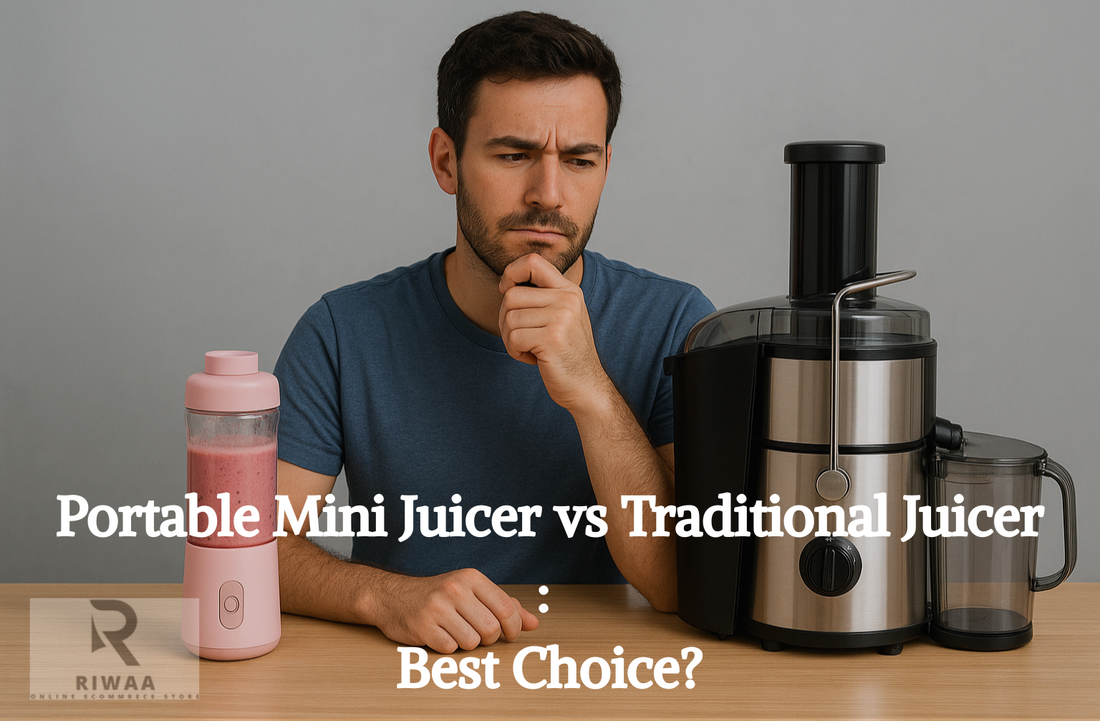
Portable Mini Juicer vs Traditional Juicer: Best Choice?
Introduction
Juicing is no longer just a kitchen hobby. It has become a lifestyle choice for people who want fresh, healthy drinks at their fingertips. But when it comes to choosing a juicer, the debate often narrows down to two contenders: Portable Mini Juicers and Traditional Juicers. Each has its strengths, weaknesses, and best use cases. Let’s break it down in detail so you can decide which one suits your lifestyle.
What Counts as a “Portable Mini Juicer”?
Portable mini juicers are compact, lightweight devices designed to let you make fresh juice anywhere—at home, the office, gym, or even outdoors. They are powered by rechargeable batteries (usually USB-chargeable), making them convenient for travel or daily commutes. These juicers usually serve as single-serve smoothie blenders but can also handle light juicing.
Bottle-style portable blenders vs true mini juicers
-
Bottle-style blenders — Blend fruits directly in the bottle, detach, and sip on the go. Great for smoothies, shakes, and quick blends.
-
True mini juicers — Focus more on extracting juice, though in smaller volumes. These are less common but offer juice separation (pulp vs liquid).
Who they’re for
-
Students who need quick breakfasts
-
Office workers who want fresh juice at their desks
-
Fitness enthusiasts for protein shakes and post-workout smoothies
-
Travelers who want lightweight, battery-powered convenience
What Counts as a “Traditional Juicer”?
Traditional juicers are larger, plug-in machines designed for continuous or high-yield juicing. They are best suited for households, juice bars, or health-focused individuals who juice regularly.
Centrifugal juicers (fast spin)
-
High-speed blades shred fruits/veggies, separating juice via centrifugal force.
-
Best for quick results but often produces foam and oxidation.
Masticating/Cold-press juicers (slow squeeze)
-
Use an auger to crush and press produce, yielding higher juice quality.
-
Retains nutrients, produces less foam, and juice lasts longer in storage.
Citrus juicers (specialized)
-
Made only for oranges, lemons, limes, and grapefruit.
-
Very simple, efficient, but limited in versatility.

Portable Mini Juicer vs Traditional Juicer
If you just want the quick takeaway: portable mini juicers are compact, convenient, and designed for on-the-go smoothies or single servings. Traditional juicers are bulkier but deliver higher yield, clearer juice, and better performance for families or juice cleanses.
One-glance comparison table
|
Feature |
Portable Mini Juicer |
Traditional Juicer |
|
Size & Portability |
Small, fits in a bag or backpack |
Large, countertop only |
|
Power |
Battery-operated, low–medium watt |
High watt, plug-in only |
|
Juice Quality |
Smoothie-style, thicker, some pulp |
Clear, smooth, less pulp |
|
Oxidation & Shelf Life |
Higher oxidation, drink quickly |
Lower oxidation, longer storage |
|
Batch Capacity |
1–2 cups per blend |
Multiple servings at once |
|
Noise |
Quieter |
Louder (especially centrifugal) |
|
Cleaning |
Quick rinse, fewer parts |
More parts, takes longer |
|
Durability |
Shorter lifespan (battery & blades wear) |
Longer lifespan with care |
|
Safety Features |
Lid-lock and auto-off |
Safety locks, overload protection |
|
Price |
Affordable, budget-friendly |
Higher upfront cost |
|
Value |
Best for convenience |
Best for long-term juicing |
|
Eco Impact |
Rechargeable but smaller life cycle |
Longer-lasting, less replacement waste |
Who should pick which (quick scenarios)
-
Students/Commuters → Portable mini juicer (lightweight, quick shakes in class or office).
-
Fitness Enthusiasts → Portable for smoothies, traditional for post-workout green juice.
-
Small Families → Traditional juicer, efficient for multiple servings.
-
Juice Cleanse Lovers → Traditional cold-press juicer, preserves nutrients.
-
Busy Parents → Portable for baby food and quick shakes, traditional for family juice batches.
Head-to-Head Comparison
Portability & footprint
Portable mini juicers are designed for mobility. They are lightweight, bottle-shaped, and often double as drinkware. You can charge them via USB and carry them in a backpack. Traditional juicers, by contrast, are countertop appliances. They require space, plug-in power, and are not practical for travel.
Power & performance
Mini juicers generally operate between 40–150 watts. This is enough for soft fruits, milkshakes, or pre-cut ingredients, but they struggle with fibrous greens or hard produce. Traditional juicers (400–1500 watts) crush through carrots, celery, and leafy greens with ease. Performance is consistent, even for daily heavy use.
Juice quality, pulp, and oxidation
Mini juicers create thicker, smoothie-like drinks with noticeable pulp. Traditional juicers extract clearer juice with higher yield, especially masticating models.
Why oxidation matters for taste & shelf life
When juice is blended at high speed with air exposure, oxidation speeds up. Portable blenders introduce more oxygen, so juice should be consumed immediately. Cold-press traditional juicers minimize oxidation, letting juice last 48–72 hours in the fridge without major nutrient loss.
Capacity & speed for batches
Mini juicers hold 300–500ml per blend, ideal for single servings. Traditional juicers process multiple fruits at once, producing liters of juice in minutes—perfect for family breakfasts or meal prep.
Noise levels
Portable mini juicers are relatively quiet, often compared to an electric toothbrush. Traditional centrifugal juicers are noisy, similar to a vacuum cleaner, while slow-masticating models are quieter but still more noticeable than mini blenders.
Cleaning & maintenance
Portable juicers are quick to rinse with water, and most parts are detachable. Traditional juicers, especially centrifugal ones, have multiple pieces (filter basket, chute, pulp container) that require thorough scrubbing.
Durability & lifespan
Mini juicers depend on battery health and small blades, which wear out faster with daily heavy use. Traditional juicers, particularly cold-press models, can last 5–10 years if maintained properly.
Safety features
Portable models include safety lids and auto shut-off to prevent accidents while blending. Traditional juicers often have advanced safety locks, overload protection, and child-safe features, giving them an edge for family use.
Cost of ownership
Upfront price vs long-term value
-
Mini Juicer: Lower initial cost, but may need replacement every 1–2 years.
-
Traditional Juicer: Higher upfront price, but longer durability and higher juice yield give better value over time.
Sustainability & waste
Mini juicers use rechargeable batteries, which reduces disposable waste but creates e-waste when the battery dies. Traditional juicers are more sustainable long-term since they last longer and produce less replacement waste. However, centrifugal models generate more pulp waste compared to cold-press juicers.

Use-Case Scenarios (Pick What Fits Your Life)
Students, commuters, office workers
A portable mini juicer is the clear winner here. It slips into your bag, charges via USB, and lets you blend fresh smoothies at school, in the office, or even while traveling. Perfect for busy schedules and single-serve convenience.
Small families & meal prep
Traditional juicers shine for households. They can produce multiple servings in one go, saving time during busy mornings. Families who prep juices in advance for breakfast or kids’ lunchboxes benefit from larger capacity and consistent yield.
Fitness & recovery smoothies
Gym-goers often prefer portable juicers for protein shakes and quick smoothies right after workouts. However, those who want nutrient-packed green juices for recovery (like celery or beet juice) will find traditional juicers more effective.
Juice cleanses, leafy greens, ginger shots
For anyone serious about detox or multi-day juice cleanses, a traditional slow-masticating juicer is the best choice. It extracts maximum nutrients from kale, spinach, wheatgrass, or ginger—something portable juicers cannot handle well.
Recipe Suitability
Smoothies, shakes, baby food (portable)
Portable mini juicers are perfect for fruit smoothies, protein shakes, milkshakes, and blending soft foods like banana puree for babies.
Clear juices, green juice, celery juice (traditional)
Traditional juicers handle fibrous greens and hard vegetables much better. They produce clear juice with less foam and better texture, especially important for celery or detox juices.
Nut milks & sorbets (where each shines)
Some traditional slow juicers come with attachments for almond milk, cashew milk, or frozen fruit sorbets. Portable blenders cannot do this. But, mini juicers can make quick flavored milk (banana milk, strawberry milk) on the go.
Buying Guide
Battery capacity & motor watts (portable)
Look for at least 2000mAh battery and 120–150 watts power if you want smooth blending without stalling.
Wattage, chute size & RPM (traditional)
For centrifugal juicers, 600–1000 watts is standard. A wide chute (3 inches) saves time as you don’t need to pre-cut much. Slow juicers with low RPM (40–80) preserve nutrients better.
Blade/auger materials & jar quality
Blades should be stainless steel, and jars should be BPA-free. For traditional juicers, augers made of durable food-grade plastic or metal ensure longevity.
Warranty, service, and spare parts availability
Always check warranty coverage. Portable juicers may offer 6–12 months, while traditional brands often give 2–5 years. Spare parts availability is critical for long-term use.
Payment methods, COD, and price awareness
In markets like Pakistan, Cash on Delivery (COD) is important. Choose reliable sellers offering clear pricing, not just flashy discounts.
Red flags and marketing gimmicks to avoid
Be cautious of exaggerated claims like “crushes any ingredient” on portable juicers or “lasts forever” warranties. Also, avoid no-name brands with no after-sales support.


Setup, Care & Cleaning
First-Use Checklist
When your juicer arrives, wash all detachable parts with warm soapy water before first use. For portables, charge the battery fully. For traditional juicers, check that the blades, filter, and pulp container are properly locked in. Never run the motor empty—it can damage the machine.
Daily Quick-Clean Routine
After each use, rinse immediately with warm water. For portables, add water and a drop of dish soap, blend for 10 seconds, and rinse. Traditional juicers benefit from a soft brush to clear mesh filters, preventing pulp buildup. Cleaning right away saves you from scrubbing dried pulp later.
Deep-Clean & Descaling (Traditional)
Over time, mineral deposits from hard water or sticky juice residue can clog traditional juicers. Once a month, soak removable parts in vinegar-water solution to descale. Scrub the mesh strainer with a toothbrush. For masticating juicers, apply food-safe lubricant on auger parts to maintain smooth operation.
Battery Care (Portable)
To extend battery life, avoid letting it discharge fully. Keep charge levels between 20% and 80%. Do not overcharge overnight. Store the juicer at room temperature, away from moisture. If unused for weeks, recharge at least once a month to prevent deep battery drain.
Common Mistakes to Avoid
Overloading Mini Jars
Portable mini juicers have smaller jars and weaker motors. Overloading with large fruit chunks strains the motor and drains the battery. Always cut produce into 1–2 cm cubes for smooth blending.
Feeding Fibrous Greens into Entry-Level Centrifugals
Budget centrifugal juicers struggle with fibrous greens like kale or celery. They clog the mesh and reduce juice yield. For green juice lovers, a masticating juicer is the better choice.
Not Straining When You Want Clear Juice
Portable blenders create thicker smoothies with pulp. If you prefer clear juice, strain through a fine mesh or cheesecloth. Skipping this step leads to disappointment for those expecting café-style clear juice.
Ignoring Safety Interlocks
Both portable and traditional juicers have safety locks. If improperly assembled, they shouldn’t run. Many users force lids or bypass safety features, risking accidents or broken parts. Always follow assembly guides.
Which One Should You Buy? (Practical Verdict)
If You Value Convenience & Portability
Go for a portable mini juicer. Ideal for students, commuters, and fitness lovers who want fresh smoothies anywhere. Lightweight, USB-chargeable, and easy to clean.
If You Value Yield & Clear Juice Quality
Pick a traditional juicer. Perfect for families, meal preppers, and anyone who prioritizes nutrient retention and higher juice extraction from greens, roots, and citrus.
The Smart “Have-Both” Combo
Many households benefit from owning both. Use the portable for quick smoothies and on-the-go blends, while the traditional handles heavy-duty juicing and large batches. This way, you cover every need without compromise.
Why Buy from RiwaaMart (If You’re in Pakistan)
Fast Local Shipping & COD
With nationwide COD service, RiwaaMart ensures quick, reliable delivery so you can start juicing without delays.
Local Support & Warranty Assistance
Unlike overseas sellers, RiwaaMart provides local warranty handling and after-sales service, saving you from costly repairs or replacements.
Curated Options for Different Budgets
From affordable portables to premium cold-press juicers, RiwaaMart offers carefully selected products that fit Pakistani households and budgets.
Conclusion
Both portable mini juicers and traditional juicers have unique strengths. If mobility, ease, and quick blending matter, go portable. If you want professional-quality juice, rich nutrients, and high yield, choose traditional. For the best of both worlds, consider owning one of each. Buying from a trusted local store like RiwaaMart ensures reliability, warranty, and peace of mind.
FAQ’s
Are portable mini juicers powerful enough for daily use?
Yes, portable mini juicers can handle soft fruits and simple smoothies daily. However, they are not designed for hard veggies or large batches like traditional juicers. They’re best for light, on-the-go use.
Which juicer is better for leafy greens?
Traditional masticating juicers are far superior for leafy greens, wheatgrass, and celery. Portable mini juicers struggle with fibrous textures. If green juice is your priority, a traditional juicer is the right choice.
Do portable mini juicers work without electricity?
Yes, most portable mini juicers come with rechargeable batteries. Once charged, they can work cord-free, making them ideal for travel, offices, or gyms. But you’ll need to recharge them regularly depending on usage.
Which juicer makes longer-lasting juice?
Traditional masticating juicers make juice that stays fresh up to 72 hours due to minimal oxidation. Portable mini juicers blend quickly, introducing air, so juices last only a few hours before losing freshness.
Is it worth having both types of juicers?
Yes, many people keep both. A portable mini juicer covers quick smoothies, protein shakes, and travel needs, while a traditional juicer is perfect for nutrient-rich, large-batch juicing at home. Together, they cover all scenarios.







